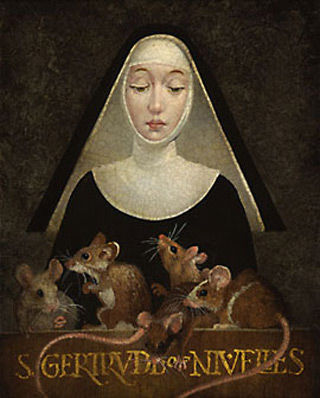
Gertrude of Nivelles depicted with rats, circa 1530.
I was bagging on St Patrick’s Day, like I do, when an Irish Twitter pal clued me into a cat connection. You might think of March 17 as St. Patrick’s Day – when we are all supposed to wear hideous Kelly green, eat raw potatoes with the skin on, guzzle Guinness at 8AM, and make stereotypical and demeaning assumptions about an entire nation, and insulting people women by asking if they have any Irish in them. What you DON’T KNOW, is that March 17th is also the feast day of a lesser-known saint: Gertrude of Nivelles, (unofficial), patron saint of cats.
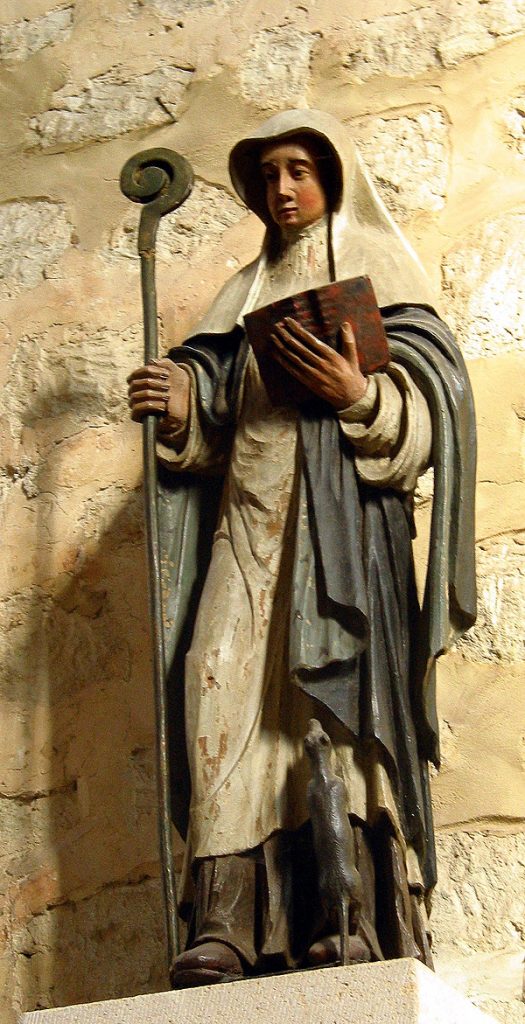 SO, for cat lovers, airline travelers, insane people, and common gardeners, today, March 17 should be a day of revelry and celebration.
SO, for cat lovers, airline travelers, insane people, and common gardeners, today, March 17 should be a day of revelry and celebration.
Gertrude became known as the patron saint of gardeners, travelers, widows, recently deceased people, the sick, the poor, the mentally ill, and travelers in search of lodging. But as the centuries wore on, she also became associated with rats. Gertrude was known to pray for the souls of those in Purgatory, and medieval artists often portrayed those souls as mice or rats. She also prayed for the rats that were overrunning the world at the time, to go away, and they did. Because of the great rat exodus, people referred to Gertrude as the patroness of cat lovers. So, yeah, people call upon Gertrude for protection from mice and rats, fever, insanity, and mental illness.
In the past few decades, faithful Catholics (and cat lovers) have made the leap from associating Gertrude with warding off rodents to associating her with cats. The idea seems to have started in the 1980s, more than 1300 years after she lived. Some sources say the first publication to link Gertrude and cats was a 1981 catalog, Metropolitan Cats, put out by the Metropolitan Museum of Art. Since then, the idea that Gertrude is the patron of cats—and cat owners—has spread. As saint expert Thomas J. Craughwell explains it, “St. Gertrude … is invoked against mice and rats, which has led cat lovers to assume that Gertrude was a cat person, and so the ideal patron of their favorite pet.” There are now many icons and paintings of her with a cat.
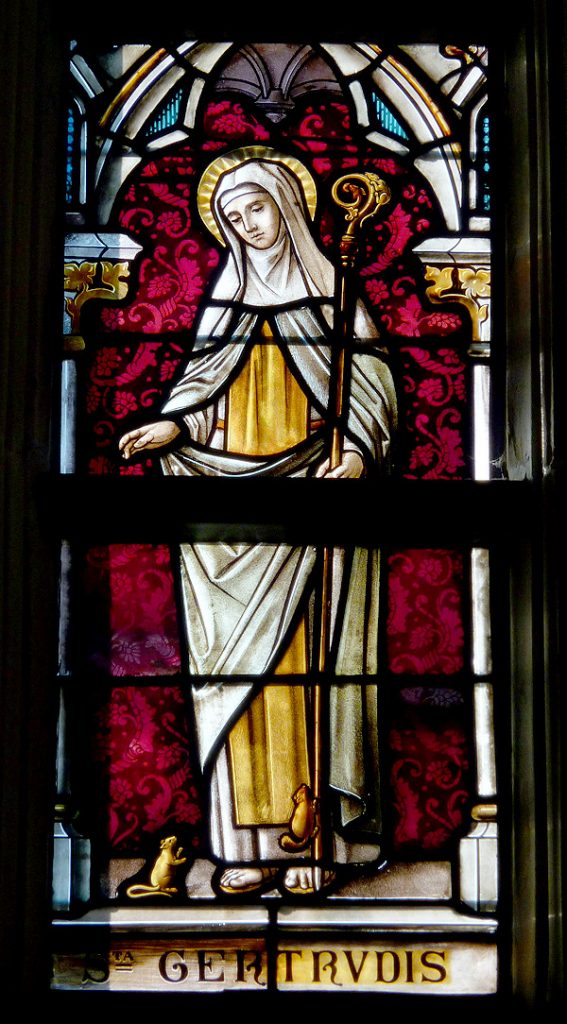
Two rats attempt to climb St. Gertrude in this stained glass window in the Belgian province of Limburg. Image by GFreihalter
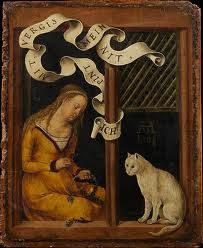
Gertrude’s iconography—the items in a painting or statue that told illiterate people who the saint was—always included mice or rats at her feet, climbing up her robes, or climbing the crozier that symbolized her role as an abbess.
Statues, illuminated manuscripts, church fresco paintings and stained glass windows commonly depict Gertrude in a garden setting, surrounded by cats, rats and mice – often with a mouse running up her staff. The animals are often held to represent souls in purgatory, for whose salvation Gertrude fervently prayed when she was alive. As recently as 1822, pilgrims left offerings at her shrine in the form of golden and silver mice. More prosaically, Gertrude and her nuns also kept cats to combat the vermin problem at Nivelles abbey.
The connection between Gertrude and rodents became solidified as veneration of her spread throughout northern Europe, and little silver or gold statues of mice were left at a shrine to her in Cologne as late as 1822. By then, she had become the saint one asked to intercede in the case of a rodent infestation; it was said that the water from her abbey’s well would chase away rats and mice.
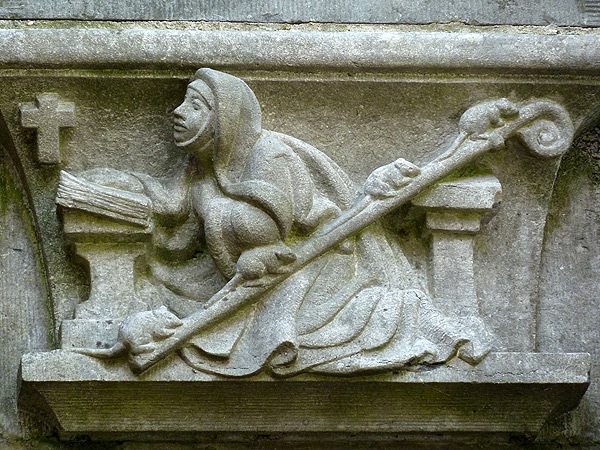
St. Gertrude of Nivelles depicted with rats circa 1530.
National Library of the Netherlands via Europeana // Public Domain
Most of what’s known about Gertrude comes from her Vita Sanctae, the official Catholic biography produced to justify her worship.
Gertrude was born around 626 into a well-connected noble family, in what’s now Belgium. Lord of the Rings fans will delight in the fact that Gertrude was the daughter of Pippin of Landen. (Although the spelling of Dad’s name changes from source to source, he’s usually referred to as Pepin.) Pippin of Landen, a powerful Frankish nobleman and political operator at the court of King Dagobert I.
St Gertrude’s family, known as the Pippinids after her dad, became the Carolingians – the most famous of whom is Charlemagne, the papally anointed Holy Roman Emperor who united most of Western Europe. So, maintaining written records of a holy aunt’s miracles and good works was politically strategic for both the Church and the Carolingians.
Gertrude lost the plot that most noble women were made to follow in her era: When she was 10, Gertrude reportedly refused—loudly and angrily—to be married to the son of a duke. In fact, she insisted that she would never marry at all.Gertrude feistily refused a marriage proposal from the son of a duke, “saying that she would have neither him nor any earthly spouse but Christ the Lord.”
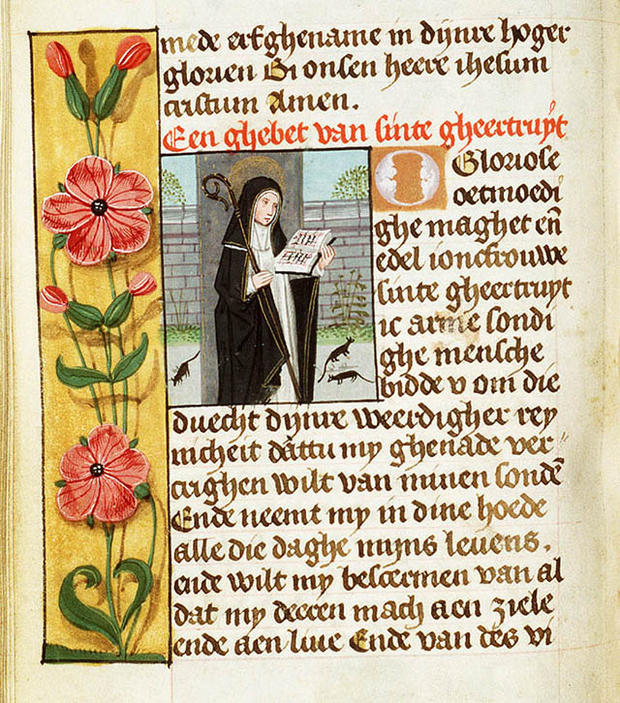 Her father died when Gertrude was around 14, and she and her mother, Itta, moved to Nivelles (south of present-day Brussels) to set up a monastery, where she became an abbess. Itta shaved her head into a monkish tonsure to deter would-be suitors from marrying into her wealthy family by force.tta and Gertrude established the monastery of Nivelles and retired to a religious life – historically, this has been one of women’s few options to preserve their intellectual, economic and sexual autonomy. When her mother died in 650, the now 24-year-old Gertrude took on sole governance of the monastery, and was known for her hospitality to pilgrims and for her devotion to scholarly and charitable works.
Her father died when Gertrude was around 14, and she and her mother, Itta, moved to Nivelles (south of present-day Brussels) to set up a monastery, where she became an abbess. Itta shaved her head into a monkish tonsure to deter would-be suitors from marrying into her wealthy family by force.tta and Gertrude established the monastery of Nivelles and retired to a religious life – historically, this has been one of women’s few options to preserve their intellectual, economic and sexual autonomy. When her mother died in 650, the now 24-year-old Gertrude took on sole governance of the monastery, and was known for her hospitality to pilgrims and for her devotion to scholarly and charitable works.
But Gertrude’s patronage of travellers relates not only to her kind treatment of pilgrims in life, but also to her second attributed miracle, in which an Irish monk beset by a great storm at sea – including a sea monster threatening to capsize the ship – prayed to her and the storm instantly subsided (because Gertrude is called upon to help travelers, that also makes her the super patron saint of people who travel with cats). Because of this legend, medieval travelers drank a toast in her honor before starting their journey. Even today in Belgium, a drink-for-the-road is called a “St. Gertrude’s Cup.” Gertrude’s hospitable treatment of Irish pilgrims was important to a Church that wished to establish its cosmopolitan reach, which is why she shares her death date with St Patrick.
She was also visited by spiritual visions and said to know most of the Bible by heart. This ascetic lifestyle, which included long periods without food or sleep, took a toll on her health, and she resigned as abbess in 656 at the age of 30. She died three years later, worn out in her early thirties, says the Cambridge Medieval History, “because of too much abstinence and keeping of vigils”.
A visiting Irish monk, whose brother Gertrude had sheltered, predicted she would die on St Patrick’s Day, and that “blessed Bishop Patrick with the chosen angels of God… are prepared to receive her”. St. Patrick himself is said to have watched over her on her deathbed.
St Francis of Assisi, a man saint, sucks up all the animal oxygen by being the patron saint of all animals, including cats, On a day that has become basically license foe revolting public displays of boorish drunken masculinity, maybe us cat lovers and insane people, can honor a saint whose domains of patronage have traditionally been belittled as feminised and domestic, including cats.
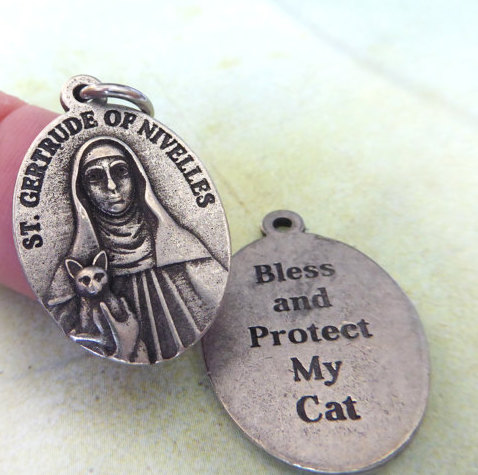
I bought these on Etsy for my cats, from PocketFullofPrayers to protect Snopes and GrayZ from the coyotes prowling my cul de sac
This is dedicated to my sister, Kristen, who loves cats but hates rats but you can’t separate the two.